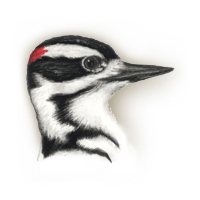|
Field
Guide IDs: BREEDING:
Decid or conif
forest, wooded swamps, orchards, woodland,
well-wooded towns and parks. 1 brood. DISPLAYS:
Pair bonds formed
in winter. Duet drumming; female may tap at
symbolic (unsuitable) nest site or at suitable
sites, and perform quivering, fluttering flight to
attract male. Many apparent courtship displays may
be aggressive or appeasement. NEST:
Excavation takes 1
- 3.5 weeks (averaging 20 days). Usu annual. Lined
with chips. Male usu selects site. EGGS:
White. 1.0" (25
mm). DIET:
Insects (75% to
95%), sap from sapsucker hole. Winter diet includes
acorns, hazelnuts, beechnuts. May cache
insects. CONSERVATION:
Winter resident.
Blue List 1975-82, Special Concern 1986; widely
reported as declining. NOTES:
Female incubates in
day, male at night; female does most of brooding.
Male forages away from nest, making few visits but
brings large prey; female feeds at start and end of
day, foraging within hearing distance of young and
making frequent trips. Parental care continues
several weeks beyond fledging. Nest cavities often
appropriated by House Sparrows and starlings. Males
tend to forage higher than females in
winter. ESSAYS: Island
Biogeography;
How
Do We Find Out About Bird
Biology?;
Nonvocal
Sounds;
Hoarding
Food;
Who
Incubates? REFERENCES:
Kilham, 1968, 1969,
1983; Morrison and With, 1987. |
